Ocean Liners at the V&A Museum explores the history of transatlantic seafaring design

Welcome to a huge, overbearing concoction of glittering surfaces, richly embellished craft and careful attention to everything from the biggest object right down to the tiniest detail. This is the V&A’s new blockbuster, ‘Ocean Liners: Speed and Style’, a suitably grand evocation of the golden age of one of history’s most venerated forms of transport.
‘Ocean Liners’ taps into many of our contemporary fascinations and obsessions, including glamour, nationalism, class, art, design, sex and death. The liner represented the apogee of the first industrial age, a floating city of unparalleled sophistication built on the raw power of shipbuilding and steam. The very best artists, designers, architects, craftspeople and stylists were employed to shape these vessels, pouring themselves into every last conceivable detail, from curtains to cutlery, while the industrial might of nations ground out the iron, steel and millions of rivets that shaped each boat.

Model of a quadruple expansion tandem engine, designed by Walter Brock and made by David Carlaw, for William Denny Brothers, Dumbarton, Scotland, 1887. © CSG CIC Glasgow Museums
The V&A’s new show, curated by Ghislaine Wood and Daniel Finamore, tracks the origins of the transatlantic crossing from the early days of mail ships and mass immigration, when the cargo and the destination mattered far, far more than the cramped, uncomfortable journey. But as the moneyed, leisured upper classes started to spread their wings, the ocean liner came into its own, a grand hotel at sea offering glamorous social interaction and company, entertainment and dining of the very highest quality. Class mattered more at sea than on land, and different levels of social status were conveyed unambiguously through design.
Governments started to see their liner fleets as floating embassies for national identity and strength, and the Blue Riband – awarded to the fastest Atlantic crossing – changed hands several times in the 1920s and 30s. There were other factors at play; the big liners had an essential role in carrying troops and equipment during the war, so it made sense for governments to bankroll their construction in times of peace. The boats provided the capacity, but the shipping companies – Cunard, White Star, the Compagnie Générale Transatlantique, United States Lines and so on – provided the glitz, as liners evolved from the cluttered Edwardian splendour seen in White Star’s Titanic and Olympic to the sleek, populist modernity of the art deco era.
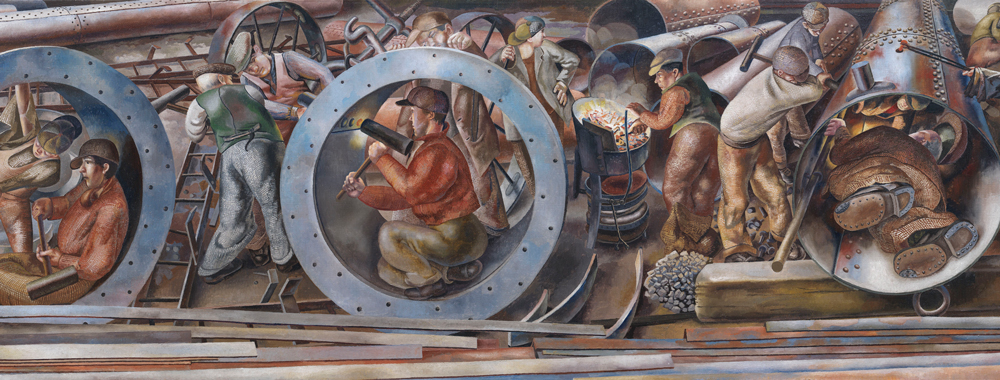
Detail of ‘Riveters’ from the series ‘Shipbuilding on the Clyde’, by Stanley Spencer, United Kingdom, 1941.
The exhibition emphasises the theatrical, from the room-sets containing reclaimed artwork and furniture to the large-scale recreation of a grand salon, all mannequins and mirrors and wall-to-wall projections of the Atlantic horizon. The ocean liner inspired some of the most evocative and beautiful posters ever printed, but the total design approach extended to all areas, from menu cards to the corporate architecture of their head offices. The most splendid era of all – the late 1920s and 30s – was of course curtailed by war, and the sheer scale of the waste is still staggering; the Normandie, perhaps the ultimate art deco object, only sailed for four years from 1935–39, before catching fire and sinking as it was being converted to a troop carrier.
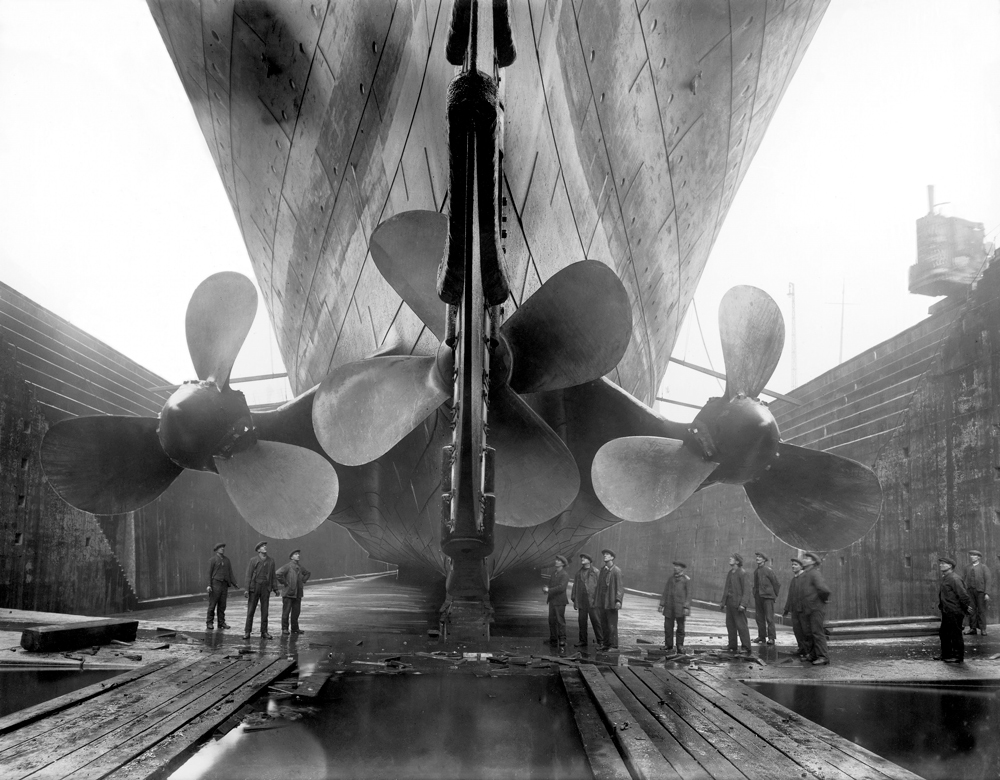
Titanic in dry dock, c.1911.
The post-war era was more populist, and the strict social stratification of the ocean liner started to become a little more relaxed. Names like Marion Dorn, Edward Ardizzone, the Cassons, Edward Bawden, Gio Ponti, David Hicks, Ernest Race, Robert Heritage and more, turned their hand to the interiors of the new-era liners, fighting an unwinnable war against commercial aviation. The exhibition captures these dying days of unassailable style, and the 250 objects take the visitor on an intriguing and bittersweet voyage, the extremes of which will probably never be seen again. Cruise ships are still a thing, of course (the exhibition is sponsored by culture specialist Viking Cruises), but the scale and drama of the big ocean liner remains a potent symbol of our vision of luxury travel.

Left, Paquebot ‘Paris’, by Charles Demuth, United States, 1921–22. © Columbus Museum of Art, Ohio. Right, Empress of Britain colour lithograph poster for Canadian Pacific Railways, by JR Tooby, Canada (possibly), 1920–31.

Silk georgette and glass beaded ‘Salambo’
dress, Jeanne Lanvin, Paris, 1925. Previously owned by Miss Emilie Grigsby. Donated by Lord Southborough.
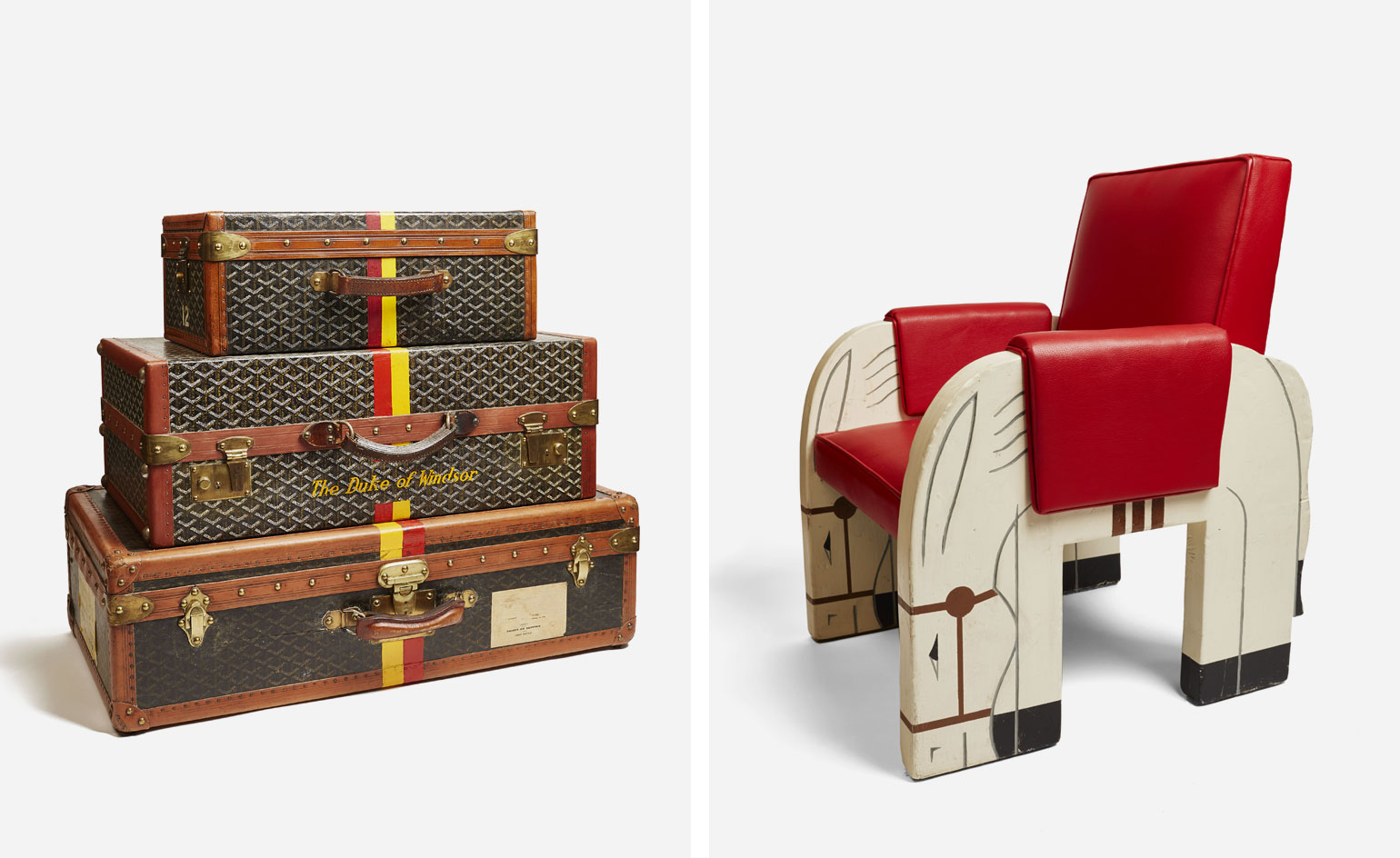
Left, luggage previously belonging to the Duke of Windsor, Maison Goyard, 1940s. Right, children’s chair from the first class playroom on Normandie, by Marc Simon and Jacqueline Dutch, France, 1934. California
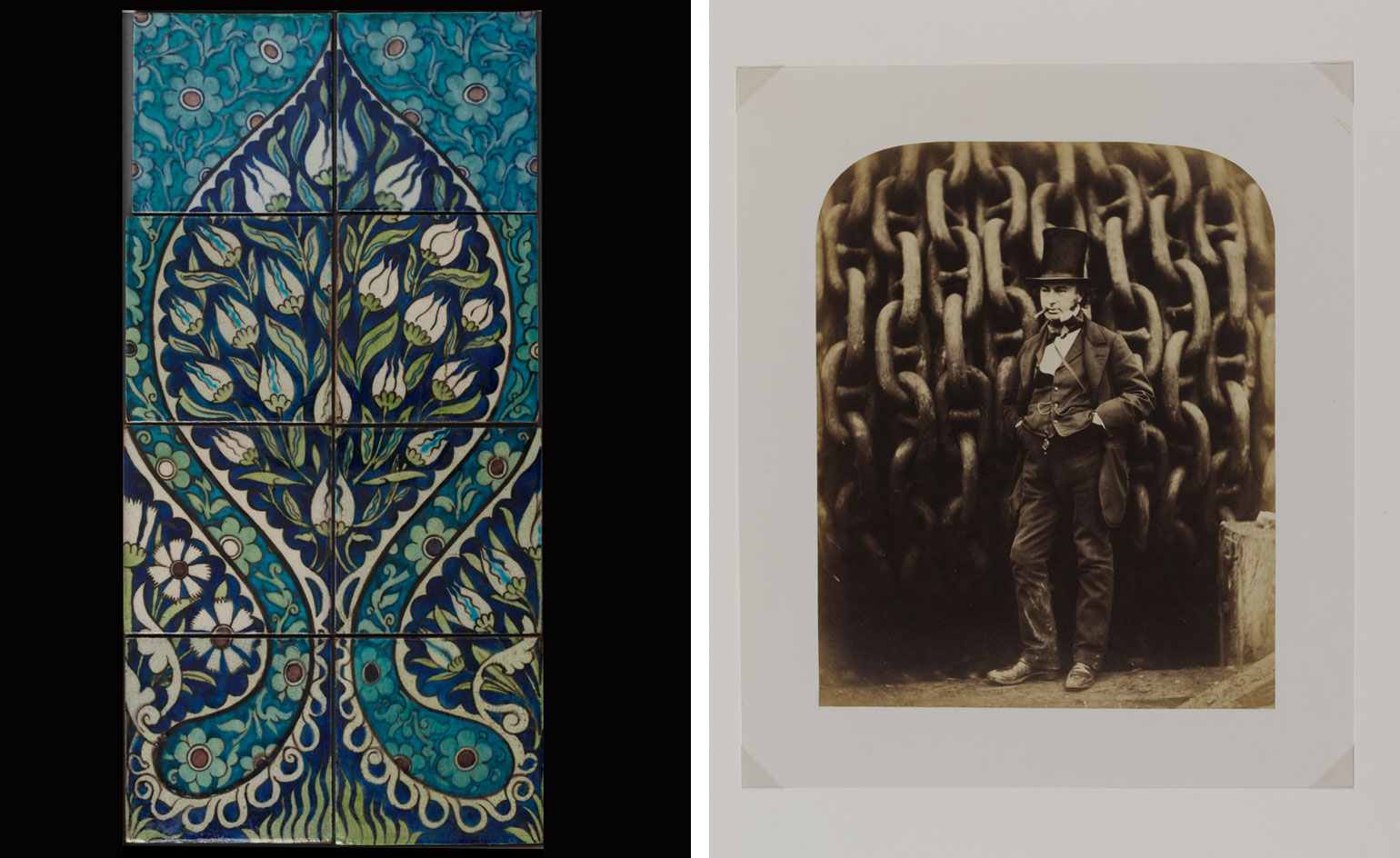
Left, painted earthenware tile panel for the saloon on Sutlej, by William de Morgan, United Kingdom, c.1882.© Victoria and Albert Museum. Right, Isambard Kingdom Brunel and the launching chains of the Great Eastern, by Robert Howlett, United Kingdom, 1857.

Panel from The Rape of Europa for the first-class grand salon on Normandie, by Jean Dupas, made for Jacques-Charles Champigneulle, France, 1934. California
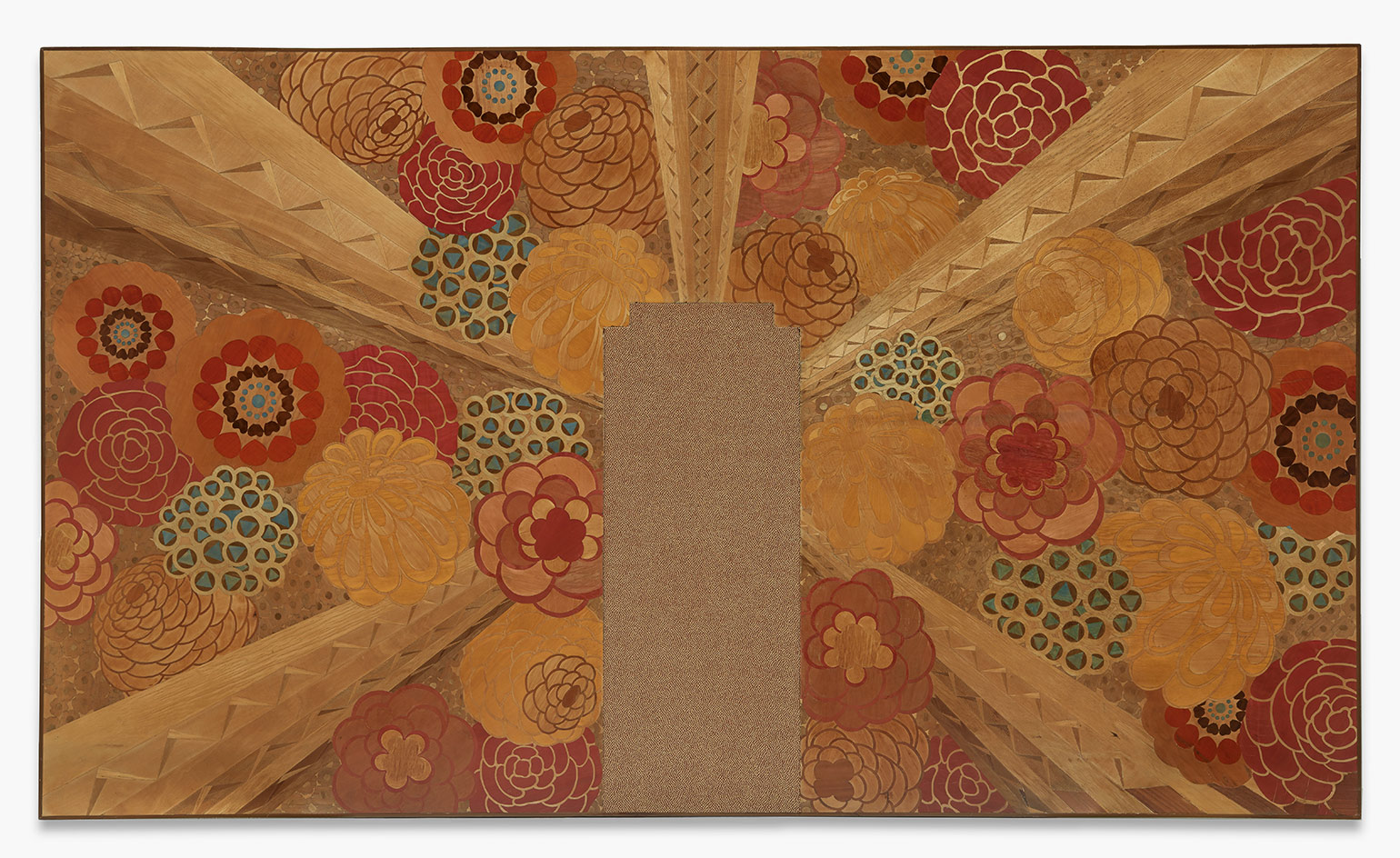
Wooden wall panel from the Beauvais deluxe suite on Île-de-France, by Marc Simon, France, 1927.
INFORMATION
‘Ocean Liners: Speed and Style’ is on view until 17 June. For more information, visit the V&A Museum website
ADDRESS
Receive our daily digest of inspiration, escapism and design stories from around the world direct to your inbox.
Victoria & Albert Museum
Cromwell Road
London
SW7 2RL
Jonathan Bell has written for Wallpaper* magazine since 1999, covering everything from architecture and transport design to books, tech and graphic design. He is now the magazine’s Transport and Technology Editor. Jonathan has written and edited 15 books, including Concept Car Design, 21st Century House, and The New Modern House. He is also the host of Wallpaper’s first podcast.
-
 Stay at Patina Osaka for a dose of ‘transformative luxury’ in western Japan
Stay at Patina Osaka for a dose of ‘transformative luxury’ in western JapanFrom nature-inspired interiors to sound-tracked cocktails and an unusually green setting, Patina Osaka is a contemporary urban escape that sets itself apart
-
 12 photographers vie for Prix Pictet 2025, lenses firmly focused on sustainability
12 photographers vie for Prix Pictet 2025, lenses firmly focused on sustainabilityPrix Pictet is the world’s leading award for photography and sustainability. Here’s how the 2025 shortlist responded to this cycle’s theme, ‘Storm’
-
 The Standard, Brussels makes a stylish case for work-life balance
The Standard, Brussels makes a stylish case for work-life balanceThis playful yet polished city escape blends global flair, local flavour, and rooftop views worth lingering over
-
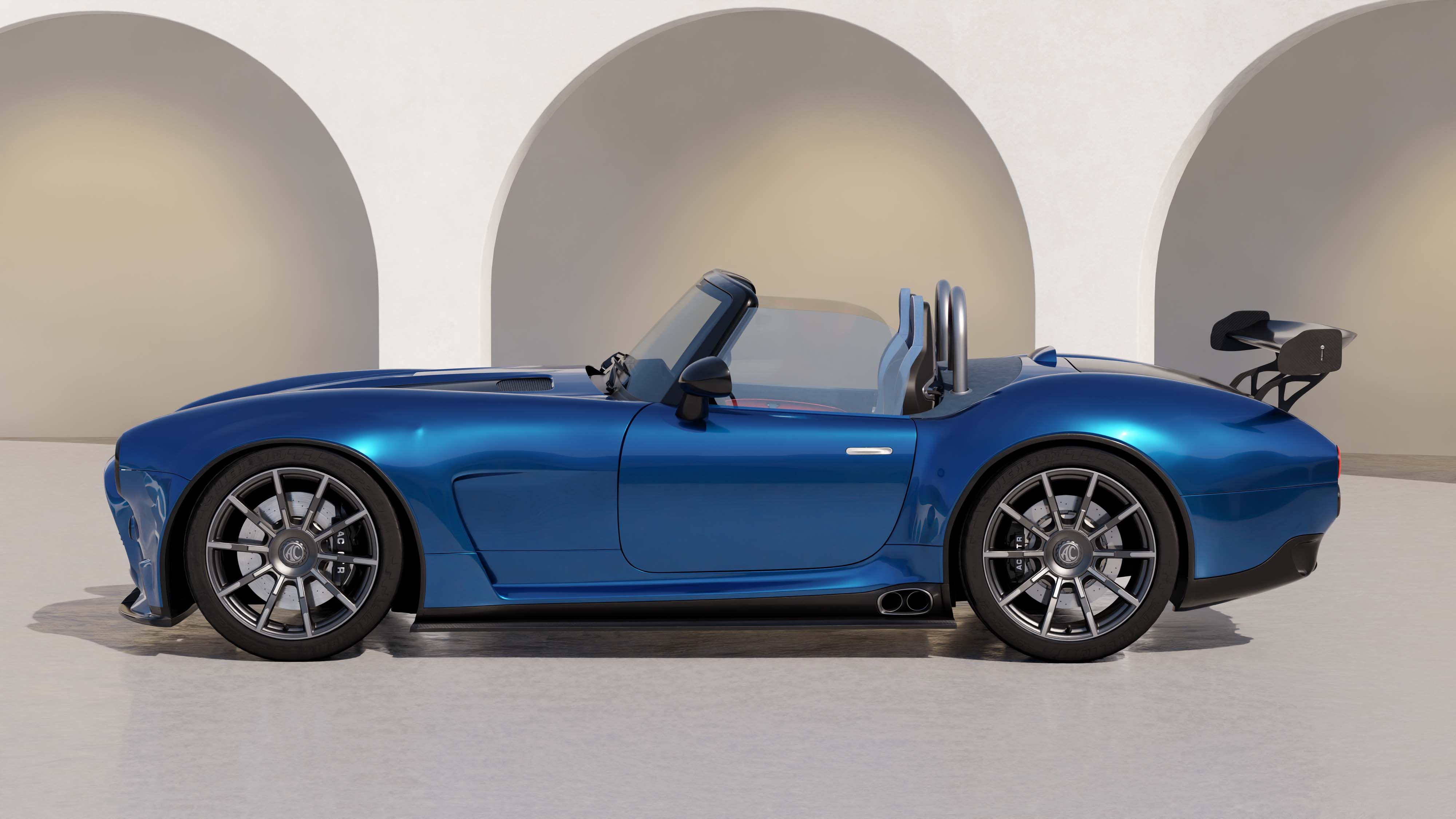 Venerable British car-maker AC goes OTT with the high-output, low-slung AC GT SuperSport
Venerable British car-maker AC goes OTT with the high-output, low-slung AC GT SuperSportPitched at all-American fans of the original AC Cobra, the GT SuperSport is a fearsome two-seat roadster with more muscle than ever before
-
 Gulfstream’s newly refurbished London Design Centre offers myriad ways to spec your jet
Gulfstream’s newly refurbished London Design Centre offers myriad ways to spec your jetPurchasing a private jet requires a cavalcade of design decisions. Gulfstream now offers its London customers a new Sales and Design Centre for them to make their decisions at leisure
-
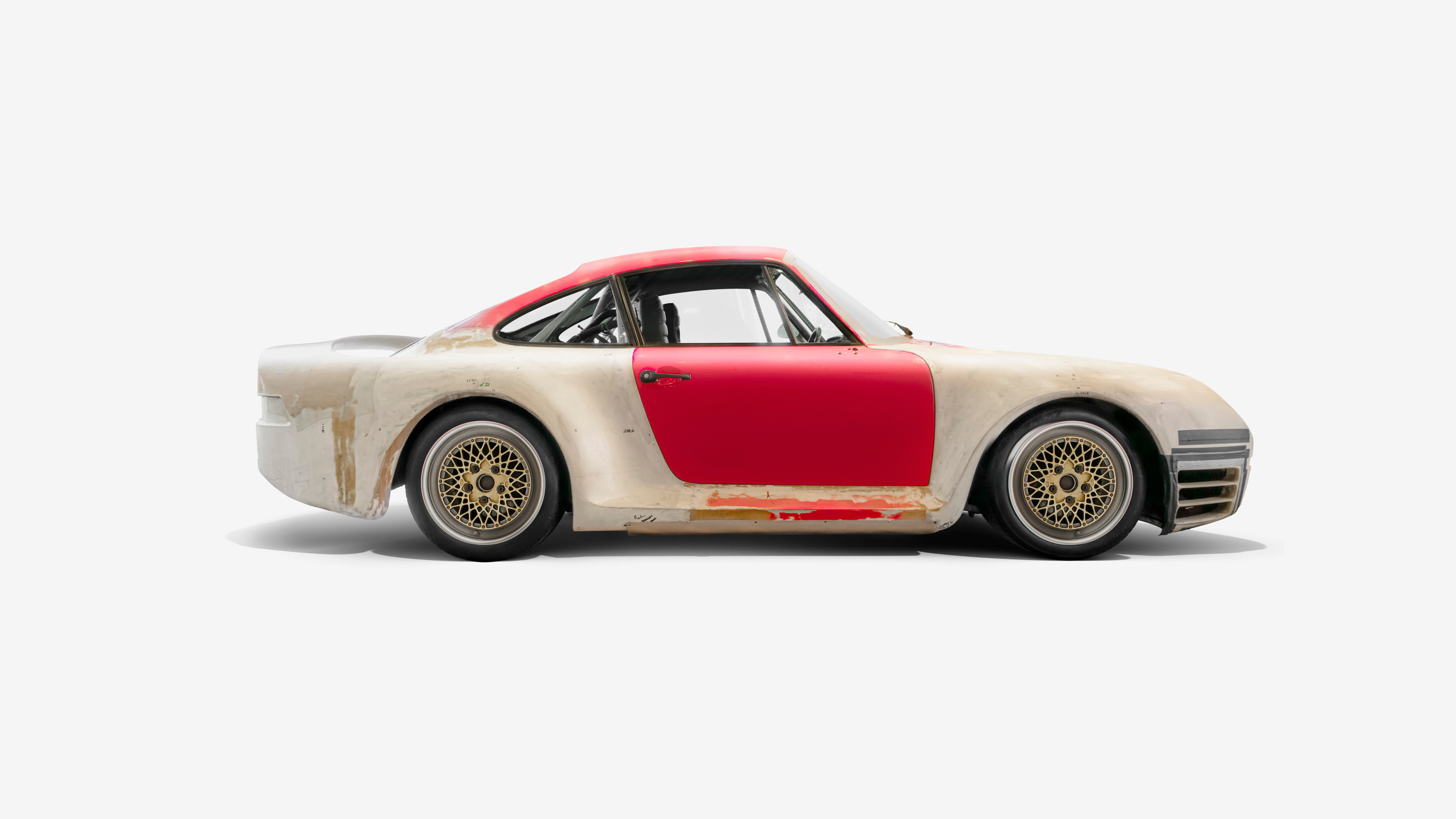 ‘Wundercar’ celebrates the ineffable aura of the Porsche 959, the first true hypercar
‘Wundercar’ celebrates the ineffable aura of the Porsche 959, the first true hypercarCurated by London creatives INK, ‘Wundercar’ is a London exhibition dedicated to the image and influence of Porsche’s seminal 959, a true icon of 1980s engineering
-
 EV start-up Halcyon transforms a classic 1970s Rolls-Royce into a smooth electric operator
EV start-up Halcyon transforms a classic 1970s Rolls-Royce into a smooth electric operatorThis 1978 Rolls-Royce Corniche is the first fruit of a new electric restomod company, the Surrey-based Halcyon
-
 China’s Leapmotor pounces on the European car market with its T03 city car and C10 SUV
China’s Leapmotor pounces on the European car market with its T03 city car and C10 SUVLeapmotor’s tiny electric city car could be just the tonic for cramped urban Europe. We sample the T03 and its new sibling, the fully loaded C10 SUV, to see if the company’s value proposition stacks up
-
 We make off with a MOKE and experience the cult EV on the sunny backroads of Surrey
We make off with a MOKE and experience the cult EV on the sunny backroads of SurreyMOKE is a cult car with a bright future. Wallpaper* sat down with the company's new CEO Nick English to discuss his future plans for this very British beach machine
-
 Meet the Alvis continuation series – a storied name in British motoring history is back
Meet the Alvis continuation series – a storied name in British motoring history is backThe Alvis name is more than a century old yet you can still order a factory-fresh model from its impressive back catalogue, thanks to the survival of its unique archive
-
 Hongqi’s Giles Taylor on the Chinese car maker's imminent arrival in the UK
Hongqi’s Giles Taylor on the Chinese car maker's imminent arrival in the UKHongqi makes China's state limousines. By 2026, it'll have a pair of premium EVs on UK roads. Giles Taylor, its VP of design, tells us about its design approach, and ambition in Europe